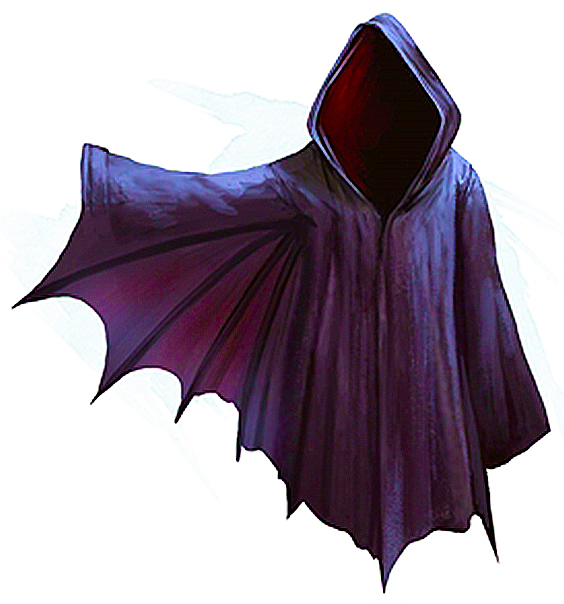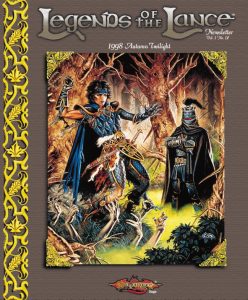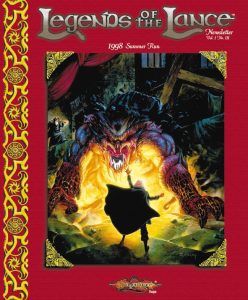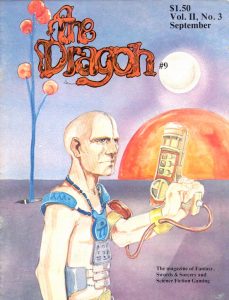
Published in 1993 by TSR, Inc., "The Magic Encyclopedia Volume Two" is the second and final installment in a two-part series that meticulously catalogs the myriad of magical items from various Dungeons & Dragons publications. This volume, like its predecessor, is a valuable resource for both Dungeon Masters (DMs) and players, providing detailed information on approximately 5,700 magical items that were printed between 1974 and 1991. Compiled and designed by Connie Rae Henson and Dale "Slade" Henson, and featuring cover art by Fred Fields, this volume continues the legacy of its predecessor by offering a wealth of magical artifacts that can enhance any fantasy role-playing game.
Historical Significance
"The Magic Encyclopedia Volume Two" serves as a historical compendium, preserving the rich legacy of Dungeons & Dragons (D&D) through its exhaustive listing of magical items. This volume includes items from numerous sources such as accessories, boxed sets, flip books, folios, hardbound books, magazines, modules, and newsletters. Many of these items originate from out-of-print products that are now considered rare collectibles, adding an additional layer of historical significance to the compilation. The encyclopedia spans the entire alphabet from Goggles to Zwieback, ensuring that every magical artifact from this period is documented.
Structure and Organization
The encyclopedia is meticulously organized to facilitate easy navigation and quick reference, making it an indispensable tool for both novice and veteran Dungeon Masters. The content is divided alphabetically, with Volume Two covering items from Goggles through Zwieback. This alphabetical arrangement ensures that users can effortlessly find the items they need without sifting through pages of unrelated content.
Each entry in the encyclopedia provides detailed and precise information, including the item's name, experience point (EP) value, gold piece value, and the original product reference where the item was first described. This level of detail is crucial for Dungeon Masters who need to understand the context and value of each item to incorporate it effectively into their campaigns. The inclusion of experience and gold values helps maintain game balance and provides clear guidelines for rewarding players.
The structure of the encyclopedia also includes cross-references and indexes, which enhance its utility. Items are grouped by categories such as "Amulet" or "Sword," allowing DMs to compare similar items and choose the most suitable one for their needs. This categorical grouping is particularly useful when planning specific encounters or treasure hoards, as it provides a quick overview of available options within a particular type of item.
Additionally, the product references included with each item are a boon for those who wish to delve deeper into the lore and history of a particular artifact. By providing the source of each item's full description, the encyclopedia not only serves as a standalone reference but also as a gateway to exploring the broader Dungeons & Dragons literature. This interconnectedness enriches the user's experience and offers a comprehensive understanding of the game's magical landscape.

Experience and Gold Values
The experience point (EP) values assigned to each item in "The Magic Encyclopedia Volume Two" are designed to reward players for acquiring and using these artifacts in their adventures. In the original AD&D game, experience was awarded for items kept and used by players, reflecting the value of the item as a reward for exploration and successful adventuring. In the AD&D 2nd edition, the focus shifted slightly, awarding experience to characters who create magical items, emphasizing the skill and effort involved in crafting powerful artifacts.
The gold piece values provided for each item serve as a baseline worth, offering Dungeon Masters a clear reference for balancing the economy of their campaigns. These values help ensure that magical items retain their sense of wonder and value without unbalancing the game. The prices are not set in stone and can be adjusted to fit the specific needs and setting of any campaign, making them highly versatile.
When adapting these values for Dungeons & Dragons 5th Edition (5e), Dungeon Masters should consider the differences in the game's economy and progression. In 5e, magical items are generally not given a specific gold value in the official rules, as the game aims to maintain a sense of rarity and wonder around them. However, the values from the encyclopedia can still be useful as a guideline for DMs who wish to include a more structured economy in their campaigns.
Experience points in 5e are typically awarded for overcoming challenges, completing quests, and defeating enemies, rather than for acquiring items. However, DMs can use the EP values from the encyclopedia to reward players in a similar fashion, providing experience for discovering and utilizing significant magical artifacts. This approach can add an extra layer of incentive for players to seek out and engage with these items, enhancing the sense of accomplishment and progression.
Pathfinder 2nd Edition (2e), known for its intricate item mechanics and extensive character customization, also benefits greatly from the comprehensive listings in this volume. The detailed entries allow for precise conversion, ensuring that each item retains its unique properties and integrates smoothly into the Pathfinder ruleset. This provides Game Masters with an expanded toolkit to create immersive and engaging adventures, filled with magical items that enrich the narrative and offer strategic depth.
The flexibility of these values allows DMs to tailor the rewards to the power level and needs of their party. For example, in a low-magic campaign where magical items are rare and highly prized, the gold values can be increased to reflect their scarcity. Conversely, in a high-magic setting where items are more common, the values can be adjusted downward to maintain balance.

Practical Use in Campaigns
"The Magic Encyclopedia Volume Two" is designed for practical use in both AD&D and D&D campaigns. The book's introduction offers guidance on converting items for use in different versions of the game, ensuring that the content is versatile and adaptable. This adaptability extends to Dungeons & Dragons 5th Edition (5e) and Pathfinder 2nd Edition (2e), allowing Dungeon Masters (DMs) to seamlessly integrate these magical items into their more modern campaigns.
For D&D 5e, the encyclopedia provides a wealth of magical artifacts that can be easily adapted to fit the edition's mechanics. The structured format and detailed descriptions make it straightforward to convert items, ensuring they maintain their intended impact and balance within a 5e setting. Whether you are looking to introduce a rare and powerful artifact or a more common magical trinket, "The Magic Encyclopedia Volume Two" offers a rich repository of options that can enhance the wonder and excitement of your campaign.
Pathfinder 2e, known for its intricate item mechanics and extensive character customization, also benefits greatly from the comprehensive listings in this volume. The detailed descriptions and comprehensive listings allow for precise conversion of items, ensuring they fit smoothly into the Pathfinder ruleset. This provides Game Masters (GMs) with an expanded toolkit to craft intricate and engaging narratives, filled with magical items that add strategic depth and enrich the overall gameplay experience.
The inclusion of a sample magic shop, Chemcheaux, illustrates how DMs and GMs can integrate the encyclopedia's contents into their campaigns, providing players with opportunities to discover, trade, and utilize magical items. Chemcheaux, with its detailed layout, security measures, and political intrigue, serves as a ready-made location that can be dropped into any campaign, offering a dynamic and interactive environment for players to explore. The shop's specialization in certain magical items and its network of franchises across multiple worlds add layers of complexity and intrigue, making it a versatile addition to any setting.
The practical guidance on converting items for use in different editions, combined with the immersive example of Chemcheaux, ensures that "The Magic Encyclopedia Volume Two" is not just a historical compendium but a living resource that continues to bring magic and excitement to tabletop gaming. Whether you are running a nostalgic AD&D session, a streamlined 5e adventure, or an intricate Pathfinder 2e campaign, this encyclopedia equips you with the tools to create memorable and magical experiences for your players.

Indispensable Resource
"The Magic Encyclopedia Volume Two" is an indispensable resource for Dungeons & Dragons enthusiasts, offering a treasure trove of magical items that can enhance any campaign. Its comprehensive and organized approach makes it easy to use, while the historical significance of its contents adds depth to the gameplay experience. Whether you are a seasoned DM or a newcomer to the world of D&D, this encyclopedia is sure to become a valued part of your collection, providing endless possibilities for magical adventures.
For Dungeons & Dragons 5th Edition (5e) players, this volume offers a structured and detailed reference that can seamlessly integrate into modern gameplay. The clear guidelines for converting items ensure that the magical artifacts maintain their intended impact and balance within a 5e campaign. This makes the encyclopedia a valuable tool for creating immersive and captivating adventures that resonate with both veteran players and newcomers.
Pathfinder 2nd Edition (2e) players will also find "The Magic Encyclopedia Volume Two" to be a significant asset. The detailed descriptions and comprehensive listings allow for precise conversion of items, ensuring they fit smoothly into the Pathfinder ruleset. This provides Game Masters with an expanded toolkit to craft intricate and engaging narratives, filled with magical items that add strategic depth and enrich the overall gameplay experience.
The encyclopedia's adaptability and versatility extend beyond just AD&D, making it relevant and useful for multiple editions of Dungeons & Dragons and Pathfinder 2e. The inclusion of practical examples, such as the Chemcheaux magic shop, demonstrates how these items can be seamlessly woven into any campaign setting, offering dynamic and interactive environments for players to explore.
Overall, "The Magic Encyclopedia Volume Two" bridges the gap between the classic and modern eras of role-playing games, providing timeless resources and inspiration for enhancing the magical aspects of any fantasy campaign. Whether you are running a nostalgic AD&D session, a streamlined 5e adventure, or an intricate Pathfinder 2e campaign, this encyclopedia equips you with the tools to create memorable and magical experiences for your players. Its depth, breadth, and historical significance ensure that it will remain a treasured resource for years to come, continually inspiring and enriching the world of tabletop role-playing games.






